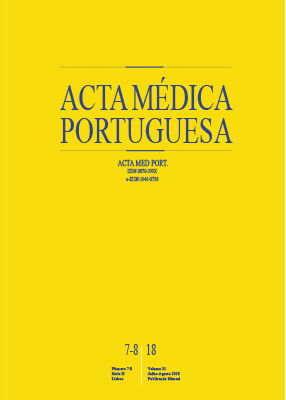Diabetes Gestacional: Serão os Atuais Critérios de Diagnóstico Mais Vantajosos?
DOI:
https://doi.org/10.20344/amp.10135Palavras-chave:
iabetes Gestacional/diagnóstico, Diabetes Gestacional/epidemiologia, PortugalResumo
Introdução: Não existe consenso internacional quanto aos critérios de diagnóstico da diabetes gestacional. Em Portugal, os critérios de Carpenter e Coustan foram substituídos por uma adaptação dos critérios da International Association of Diabetes and Pregnancy Study Groups. O objetivo deste estudo foi comparar a incidência e outcomes obstétricos/perinatais das grávidas com diabetes gestacional segundo os critérios atuais e prévios.
Material e Métodos: Estudo retrospetivo de 1218 gestações únicas complicadas com diabetes gestacional cuja vigilância/parto ocorreu entre 2008-2015. Consideraram-se dois grupos: diagnóstico pelos critérios da Direção Geral da Saúde – International Association of Diabetes and Pregnancy Study Groups (grupo 1); diagnóstico segundo Carpenter e Coustan (grupo 2), tendo sido feita análise estatística comparativa.
Resultados: A incidência da diabetes gestacional duplicou (9,4% vs 4,6%) e o número de consultas/ano aumentou consideravelmente (~ 3 000 vs ~ 2 000). No grupo 1 verificou-se um risco inferior de recém-nascidos macrossómicos em relação ao grupo 2 [RR 0,44 (IC (95%): 0,26 – 0,76)], e um risco mais elevado de recém-nascidos leves para a idade gestacional (LIG) [RR 1,99 (IC (95%):1,19 – 3,31)]; um risco cerca de seis e quatro vezes superior de hipoglicémia [RR 6,30 (IC (95%): 3,39 – 11,71)] e hiperbilirrubinémia [RR 3,89 (IC (95%): 2,25 – 6,72)] neonatais, respetivamente. Não houve diferenças em relação a outros outcomes.
Discussão: A redução dos recém-nascidos macrossómicos não resultou em melhoria dos outcomes, havendo um aumento dos recém-nascidos leves para a idade gestacional bem como de complicações neonatais. Os critérios atuais poderão associar-se a maiores gastos em saúde, devido ao aumento considerável da incidência de diabetes gestacional e maior vigilância em consultas, sem benefícios obstétricos/perinatais.
Conclusão: A aplicação dos critérios da Direção Geral da Saúde – International Association of Diabetes and Pregnancy Study Groups associou-se a redução da macrossomia, não acompanhada de uma melhoria dos outcomes. É discutível o benefício destes critérios em relação aos anteriormente preconizados.
Downloads
Downloads
Publicado
Como Citar
Edição
Secção
Licença
Todos os artigos publicados na AMP são de acesso aberto e cumprem os requisitos das agências de financiamento ou instituições académicas. Relativamente à utilização por terceiros a AMP rege-se pelos termos da licença Creative Commons ‘Atribuição – Uso Não-Comercial – (CC-BY-NC)’.
É da responsabilidade do autor obter permissão para reproduzir figuras, tabelas, etc., de outras publicações. Após a aceitação de um artigo, os autores serão convidados a preencher uma “Declaração de Responsabilidade Autoral e Partilha de Direitos de Autor “(http://www.actamedicaportuguesa.com/info/AMP-NormasPublicacao.pdf) e a “Declaração de Potenciais Conflitos de Interesse” (http://www.icmje.org/conflicts-of-interest) do ICMJE. Será enviado um e-mail ao autor correspondente, confirmando a receção do manuscrito.
Após a publicação, os autores ficam autorizados a disponibilizar os seus artigos em repositórios das suas instituições de origem, desde que mencionem sempre onde foram publicados e de acordo com a licença Creative Commons









